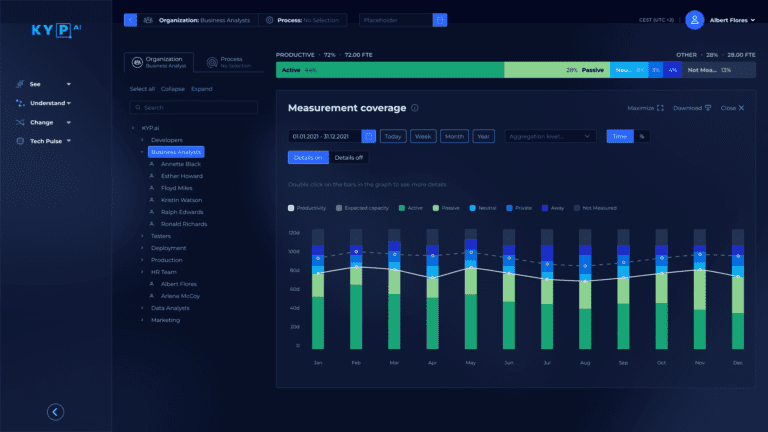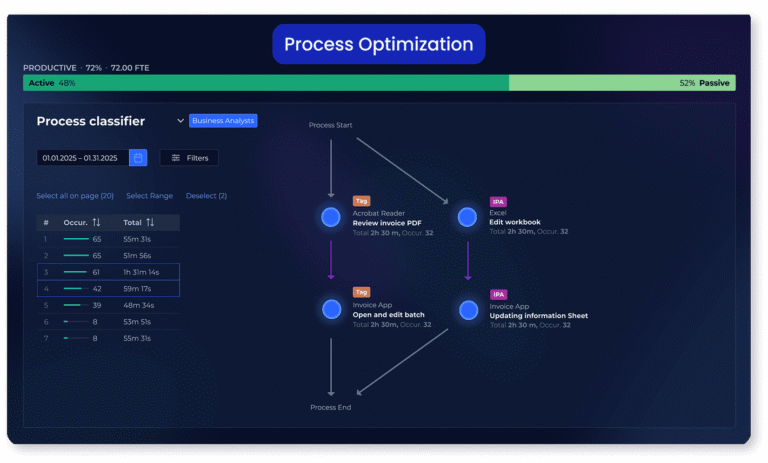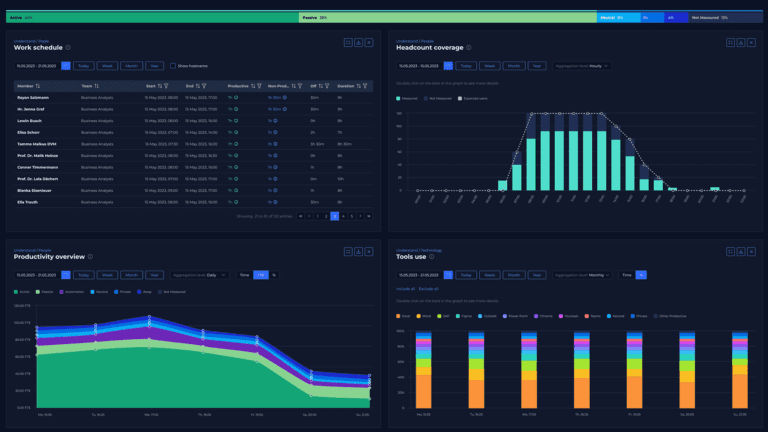Process intelligence is technology that automatically captures and analyzes how work flows through an organization’s systems, people, and processes. Combining artificial intelligence with real-time data, it transforms complex operational data into actionable insights that reveal bottlenecks, inefficiencies, and automation opportunities.
Unlike traditional process discovery that relies on interviews and documentation, process intelligence software provides a continuous, fact-based view of how work actually gets done. The outcome: data-driven decisions to optimize and automate business operations.

Key pillars of process intelligence
Process intelligence operates through four essential components that create a complete lifecycle of operational understanding:
1. Process discovery – Automatically map end-to-end workflows by capturing digital footprints across systems and user activities, revealing how processes actually execute versus how they’re documented.
2. Process analysis – Apply AI and analytics to identify patterns, bottlenecks, variations, and inefficiencies. Quantifies impact in terms of time, cost, and resource utilization.
3. Conformance checking and monitoring – Continuous, real-time visibility into process performance, tracking KPIs and alerting teams to deviations or emerging issues before they escalate.
4. Process optimization – Use deep learning and agentic AI to give prescriptive insights, suggest next best actions, and forecast ROI impact of process improvements.
Together, these pillars create a closed-loop system for continuous operational improvement.
Benefits of process intelligence software
Traditional process analysis methods leave organizations operating with outdated understanding of their operations. Process intelligence software provides the real-time, comprehensive visibility required for competitive advantage:
- Evidence-based decision making. Replace gut feelings with hard data about process performance, compliance gaps, and improvement opportunities. Every optimization decision is backed by quantifiable evidence rather than assumptions or opinions.
- Proactive problem solving. Continuous monitoring alerts teams to issues before they escalate, shifting organizations from reactive firefighting to proactive optimization. Identify and address bottlenecks before they impact business outcomes.
- Scale process improvement efforts. Rather than optimizing one process at a time, identify and address improvement opportunities across the entire organization simultaneously, like having hundreds of process experts working 24/7 to uncover inefficiencies.
- Accelerate digital transformation. Automation initiatives require accurate understanding of current processes. Process intelligence eliminates months of manual discovery, providing instant, accurate operational baselines that accelerate automation deployment and ensure initiatives target high-value opportunities.
- Measure real impact. Track actual results of improvement initiatives in real-time with concrete data on efficiency gains, cost savings, and compliance improvements—no more guessing whether changes are delivering expected returns.
- Institutional knowledge preservation. Capture and codify the tacit knowledge of experienced employees before they retire or transition, ensuring operational continuity and easier knowledge transfer to new team members.
Organizations that adopt process intelligence gain significant competitive advantages: faster adaptation to market changes, more efficient operations, and the ability to scale improvements across the enterprise.
How process intelligence works
Process intelligence follows a systematic approach to transform raw operational data into actionable business intelligence:
Step 1: Data acquisition
- Deploy lightweight data collection across data systems or workstations
- Capture process execution, user interactions, and system-to-system communications
- Create comprehensive baseline of current state operations
Step 2: Process modeling
- AI algorithms identify process patterns, variants, and deviations
- Quantify bottlenecks, redundancies, and inefficiencies
- Map dependencies between people, processes, and technology
Step 3: Generate insights
- Calculate ROI potential for each improvement opportunity
- Rank initiatives by business impact, effort, and strategic alignment
- Generate specific recommendations with supporting data
Step 4: Optimize or automate
- Implement targeted process improvements
- Generate production-ready specifications for automation platforms
- Aim to deploy changes with minimal disruption
Step 5: Monitor & iterate
- Track impact of changes in real-time within the process intelligence solution
- Identify new optimization opportunities as they emerge
- Continuously refine processes and business operations based on performance data
The key thing to remember is that process intelligence is not just a tool you switch on. This cyclical approach ensures organizations maintain operational agility and continuous improvement momentum.

Process intelligence architecture
Modern process intelligence platforms are built on four integrated layers:
Data collection layer
Captures digital footprints from every corner of your organization. Think of clicks, system interactions, and data transfers in real-time without disrupting workflow. Sources can include:
- Desktop and application activity
- System logs and API calls
- Unstructured data and communications
- Cross-system process flows
- AI-driven analysis layer
Advanced algorithms process raw data to recognize patterns, understand complex sequences, and identify anomalies. Capabilities include:
- Natural language processing for unstructured data
- Machine learning for pattern recognition
- Predictive analytics for forecasting
- Root cause analysis for inefficiencies
Output layer
Intelligence is transformed into clear visualizations, similar to business intelligence (BI) reporting:
- Interactive process maps and flowcharts
- Real-time dashboards with KPI tracking
- Bottleneck alerts and exception notifications
- Compliance and audit reports
Outcome layer
Unlike traditional BI solutions, process intelligence can give you prescriptive insights to drive measurable business impact:
- ROI-prioritized automation opportunities
- Data-driven decision support
- Performance benchmarking
- Continuous improvement roadmaps
Process intelligence vs. traditional methods
| Aspect | Traditional Methods | Process Intelligence |
| Data Source | Interviews, workshops, manual observation | Automated capture of actual execution data |
| Coverage | Small sample sizes, limited scope | Comprehensive, organization-wide visibility |
| Time to Insight | Weeks to months | Days to real-time |
| Accuracy | Subjective, prone to bias | Objective, data-driven |
| Continuous Monitoring | Point-in-time snapshots | Real-time, ongoing visibility |
| Scalability | Labor-intensive, difficult to scale | Automated, scales across enterprise |
| Hidden Variations | Often missed | Automatically detected |
| Cost | High (consultant-dependent) | Lower long-term cost |
Traditional methods suffer from fundamental limitations: subjective interpretations, small sample sizes, inability to capture real-time variations, and dependence on employees accurately describing their work. Process intelligence eliminates these constraints through automated, comprehensive, and continuous data capture.
Process intelligence vs. related technologies
Understanding how process intelligence differs from adjacent technologies is critical for selecting the right approach:
| Technology | Primary Focus | Data Source | Limitations | Process Intelligence Advantage |
| Legacy Process Mining | System-level workflows | ERP/CRM event logs | System-centric view, misses human interactions | Captures complete picture: systems + people + context |
| Legacy Task Mining | Individual desktop activities | Screen recordings, user actions | Privacy concerns, limited scope | Broader visibility with built-in privacy controls |
| Business Intelligence Dashboards | Historical reporting | Data warehouses | Lacks process-level granularity | Combines BI insights with process context |
| Robotic Process Automation (RPA) | Task automation | Pre-defined workflows | Brittle, requires predefined paths | Identifies best automation candidates with ROI data |
Process intelligence combines the strengths of these technologies while addressing their limitations. The end result: end-to-end process visibility and prescriptive insights to improve business processes beyond a linear task or process view.
Where process intelligence delivers impact
Process intelligence is transforming operations across industries by replacing assumptions with data-driven insights:
Business Process Outsourcing (BPO)
BPO companies leverage process intelligence as a competitive differentiator when responding to client RFPs and delivering services. The technology demonstrates superior operational efficiency and productivity through measurable workforce utilization improvements, task automation, and quality gains.
Process intelligence enables BPOs to prove ROI clearly to clients, showcase continuous value delivery, and accelerate transformation initiatives that outpace competitors. These capabilities are critical for winning new contracts and securing renewals in an increasingly competitive market.
Global Business Services (GBS) & shared services
GBS organizations and shared services centers face existential pressure to demonstrate strategic relevance and avoid displacement by outsourcing. Process intelligence helps these teams drive operational excellence at scale by standardizing and optimizing business processes across geographies.
The technology provides real-time capacity utilization insights and operational visibility that enable proactive workforce and process management. By serving as transformation hubs that accelerate AI and automation adoption, GBS teams use process intelligence to deliver measurable value to enterprise stakeholders and maintain their strategic positioning within the organization.
Financial services
Banks and financial institutions use process intelligence to strengthen risk management and compliance operations. The technology optimizes KYC processes for consistency, monitors AML compliance in real-time, automates regulatory filing workflows, and identifies fraud detection patterns across transactions. Leading banks have reduced their compliance review cycles by 60% through process intelligence implementation.
Healthcare & life Sciences
Healthcare organizations leverage process intelligence to optimize patient journeys and accelerate claims processing. For pharmaceutical companies, the technology transforms clinical trial efficiency and drug safety monitoring through improved adverse event tracking and GxP compliance verification. These improvements translate to faster time-to-market for therapies and measurably better patient outcomes.
Human resources
Modern HR teams use process intelligence to streamline employee lifecycle management. The technology identifies bottlenecks in onboarding workflows, optimizes performance review cycles, improves training program effectiveness, and enables data-driven workforce capacity planning. Organizations report enhanced employee experience and improved retention rates as direct results of these optimizations.
Finance & accounting
Finance departments apply process intelligence to accelerate month-end close processes and automate audit trail documentation. The technology identifies redundant steps in financial consolidation workflows and optimizes accounts payable and receivable operations. Companies implementing these improvements report cutting their closing cycles by up to 40%.
Customer service
Process intelligence helps service teams deliver faster, more consistent customer experiences. The technology reveals exactly where service workflows encounter delays, enables intelligent ticket routing, ensures quality consistency across teams, and identifies opportunities for self-service automation. These improvements drive measurable gains in both CSAT and NPS scores.
Supply chain & procurement operations
In supply chain management, process intelligence provides unprecedented visibility into order-to-delivery workflows. Organizations use these insights to optimize inventory management, streamline procurement processes, improve vendor performance monitoring, and identify consolidation opportunities. This visibility has helped companies reduce process cycle times by up to 50%.
Additional high-value use cases
Process intelligence delivers value across additional business functions. In compliance and risk management, it provides automated audit trails and continuous regulatory adherence monitoring. Strategic planning teams use process intelligence for data-backed transformation roadmaps. Resource management benefits from capacity utilization optimization and targeted cost reduction. Project management teams leverage the technology for timeline optimization and resource allocation. For digital transformation initiatives, process intelligence provides critical process readiness assessments that determine automation viability.
Why enterprise need agentic process intelligence
While traditional process intelligence reveals what is happening in your operations, the next frontier, Agentic Process Intelligence, goes further by enabling autonomous AI agents to act on those insights with precision and measurable ROI.
This represents a fundamental shift: from process visibility to autonomous process transformation.
Why agentic AI requires process intelligence
The promise of Agentic AI, autonomous agents that can execute complex workflows end-to-end, hinges on three critical requirements that most organizations lack:
Rich, structured business context: AI agents need to understand not just what to do, but why, when, and how—including company-specific nuances, dependencies, and exceptions
ROI-driven prioritization: Distinguishing between what can be automated versus what should be automated based on actual business impact
Production-ready agent code: Clear objectives, detailed action sequences, and executable instructions that agents can reliably execute at scale
Traditional process mining software provides data from system logs. Most task mining tools simply capture desktop activities. But neither delivers the complete business context and executable specifications that Agentic AI demands.
KYP.ai: the agentic process intelligence platform
KYP.ai is pioneering Agentic Process Intelligence. It’s the only platform purpose-built to enable enterprises to successfully deploy autonomous AI agents at scale.
What makes KYP.ai different:
360° Organizational View Captures and correlates data across people, processes, and technology—from task-level execution to workforce behavior to system interactions. This comprehensive visibility exposes inefficiencies and provides the rich context AI agents need to operate reliably.
Business Transformation Engine Converts raw operational data into actionable intelligence by quantifying inefficiencies and calculating automation ROI. Prioritizes high-impact opportunities aligned with business goals, ensuring you automate what should be automated, not just what can be.
Agentic AI Enabler Generates structured business context, detailed action specifications, and production-ready AI agent code—supplying autonomous agents with everything they need to execute complex workflows reliably. Works across Windows, MacOS, legacy systems, and enterprise applications—not just browser automation.
It’s Agentic AI empowerment with a focus on ROI:
- Weeks to deployment, not months
- Actionable insights within days of implementation
- 20-30% process time reduction across operations
- 40-60% reduction in risk incidents
- 6-12 month ROI timelines
Organizations deploying Agentic AI without this foundation struggle with pilots that never scale, agents that fail to adapt, and automation that delivers underwhelming business value.
KYP.ai provides the three essential ingredients for Agentic AI success: structured business context, ROI-driven prioritization, and production-ready agent code.
Discover Your Agentic Process Potential – Book a demo today
Common myths about process Intelligence
Myth #1: “Process intelligence is just expensive employee monitoring”
Reality: Process intelligence focuses on process optimization, not individual surveillance. Modern platforms include granular privacy controls, data anonymization, and purpose-built features to analyze workflows while protecting employee privacy. The goal is understanding how work flows through the organization, not tracking individuals.
Myth #2: “We already have process mining; we don’t need process intelligence”
Reality: Traditional process mining analyzes system logs (ERP, CRM) but misses the human layer. With process mining you’re missing how employees actually interact with systems, handle exceptions, and execute tasks across different tools and business applications. Process intelligence combines system-level visibility with human activity context, revealing the complete picture that process mining alone cannot provide.
Myth #3: “Manual process discovery is more cost-effective”
Reality: While manual discovery appears cheaper upfront, it’s slow, subjective, quickly outdated, and doesn’t scale. Process intelligence provides continuous, objective insights across the entire organization at a fraction of the long-term cost. Organizations achieve positive ROI within 6-12 months while maintaining always-current process visibility.
Myth #4: “Implementation takes too long and disrupts operations”
Reality: Modern process intelligence platforms like KYP.ai deploy in weeks, not months, with minimal IT involvement. Lightweight agents require no system changes or integrations initially. Organizations typically see actionable insights within days of deployment, with full enterprise visibility achieved in 2-3 months.
Myth #5: “This only works for high-volume, structured processes”
Reality: Process intelligence excels with knowledge-intensive, creative, and highly variable processes where traditional approaches fail. It captures variations, exceptions, and adaptive behaviors that make up modern knowledge work. This makes it ideal for improving the processes most difficult to optimize using conventional process discovery methods.
Frequently Asked Questions About Process Intelligence
While process mining analyzes event logs from specific systems, process intelligence takes a broader approach. It captures and analyzes all digital interactions across your organization, including unstructured data and system-to-system connections that process mining might miss. Think of process mining as reading a book’s table of contents, while process intelligence reads and understands the entire book.
Modern process intelligence platforms include robust data privacy features. They can automatically detect and mask sensitive information like PII, PHI, and financial data, ensuring compliance with regulations like GDPR, SOC2 and HIPAA while still providing valuable process insights.
Task mining focuses on individual user activities at the desktop level, while process intelligence provides end-to-end visibility across entire processes, systems, and departments. Process intelligence includes task mining capabilities but goes further by connecting individual activities into complete process flows.
Organizations typically see ROI in three main areas: operational efficiency (20-30% process time reduction), cost savings (15-25% decrease in operational costs), and improved compliance (40-60% reduction in risk incidents). The exact ROI timeline varies, but most companies report positive returns within 6-12 months of implementation.
Unlike traditional process analysis tools that require months of setup, modern process intelligence platforms can be deployed in weeks. Most organizations see their first insights within days of implementation, with full organization-wide visibility achieved within 2-3 months.
Discover Your Productivity Potential – Book a Demo Today
Book Demo








